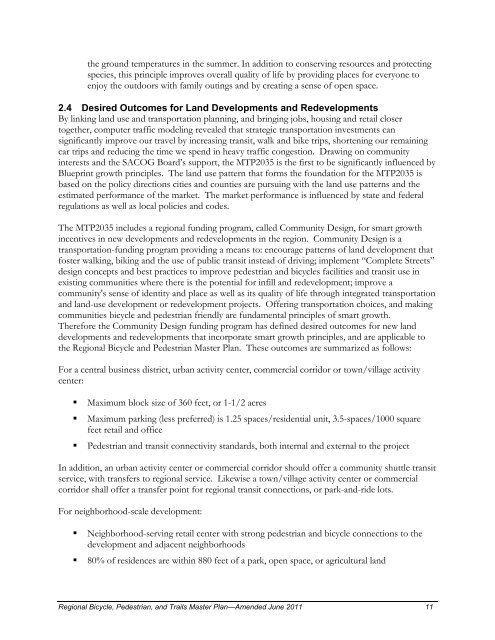Bicycle and Pedestrian Master Plan - sacog
Bicycle and Pedestrian Master Plan - sacog
Bicycle and Pedestrian Master Plan - sacog
You also want an ePaper? Increase the reach of your titles
YUMPU automatically turns print PDFs into web optimized ePapers that Google loves.
the ground temperatures in the summer. In addition to conserving resources <strong>and</strong> protecting<br />
species, this principle improves overall quality of life by providing places for everyone to<br />
enjoy the outdoors with family outings <strong>and</strong> by creating a sense of open space.<br />
2.4 Desired Outcomes for L<strong>and</strong> Developments <strong>and</strong> Redevelopments<br />
By linking l<strong>and</strong> use <strong>and</strong> transportation planning, <strong>and</strong> bringing jobs, housing <strong>and</strong> retail closer<br />
together, computer traffic modeling revealed that strategic transportation investments can<br />
significantly improve our travel by increasing transit, walk <strong>and</strong> bike trips, shortening our remaining<br />
car trips <strong>and</strong> reducing the time we spend in heavy traffic congestion. Drawing on community<br />
interests <strong>and</strong> the SACOG Board’s support, the MTP2035 is the first to be significantly influenced by<br />
Blueprint growth principles. The l<strong>and</strong> use pattern that forms the foundation for the MTP2035 is<br />
based on the policy directions cities <strong>and</strong> counties are pursuing with the l<strong>and</strong> use patterns <strong>and</strong> the<br />
estimated performance of the market. The market performance is influenced by state <strong>and</strong> federal<br />
regulations as well as local policies <strong>and</strong> codes.<br />
The MTP2035 includes a regional funding program, called Community Design, for smart growth<br />
incentives in new developments <strong>and</strong> redevelopments in the region. Community Design is a<br />
transportation-funding program providing a means to: encourage patterns of l<strong>and</strong> development that<br />
foster walking, biking <strong>and</strong> the use of public transit instead of driving; implement “Complete Streets”<br />
design concepts <strong>and</strong> best practices to improve pedestrian <strong>and</strong> bicycles facilities <strong>and</strong> transit use in<br />
existing communities where there is the potential for infill <strong>and</strong> redevelopment; improve a<br />
community's sense of identity <strong>and</strong> place as well as its quality of life through integrated transportation<br />
<strong>and</strong> l<strong>and</strong>-use development or redevelopment projects. Offering transportation choices, <strong>and</strong> making<br />
communities bicycle <strong>and</strong> pedestrian friendly are fundamental principles of smart growth.<br />
Therefore the Community Design funding program has defined desired outcomes for new l<strong>and</strong><br />
developments <strong>and</strong> redevelopments that incorporate smart growth principles, <strong>and</strong> are applicable to<br />
the Regional <strong>Bicycle</strong> <strong>and</strong> <strong>Pedestrian</strong> <strong>Master</strong> <strong>Plan</strong>. These outcomes are summarized as follows:<br />
For a central business district, urban activity center, commercial corridor or town/village activity<br />
center:<br />
• Maximum block size of 360 feet, or 1-1/2 acres<br />
• Maximum parking (less preferred) is 1.25 spaces/residential unit, 3.5-spaces/1000 square<br />
feet retail <strong>and</strong> office<br />
• <strong>Pedestrian</strong> <strong>and</strong> transit connectivity st<strong>and</strong>ards, both internal <strong>and</strong> external to the project<br />
In addition, an urban activity center or commercial corridor should offer a community shuttle transit<br />
service, with transfers to regional service. Likewise a town/village activity center or commercial<br />
corridor shall offer a transfer point for regional transit connections, or park-<strong>and</strong>-ride lots.<br />
For neighborhood-scale development:<br />
• Neighborhood-serving retail center with strong pedestrian <strong>and</strong> bicycle connections to the<br />
development <strong>and</strong> adjacent neighborhoods<br />
• 80% of residences are within 880 feet of a park, open space, or agricultural l<strong>and</strong><br />
Regional <strong>Bicycle</strong>, <strong>Pedestrian</strong>, <strong>and</strong> Trails <strong>Master</strong> <strong>Plan</strong>—Amended June 2011 11
















